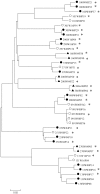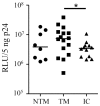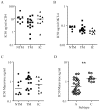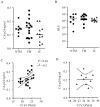HIV-1 autologous antibody neutralization associates with mother to child transmission
- PMID: 23874931
- PMCID: PMC3714266
- DOI: 10.1371/journal.pone.0069274
HIV-1 autologous antibody neutralization associates with mother to child transmission
Abstract
The HIV-1 characteristics associated with mother to child transmission (MTCT) are still poorly understood and if known would indicate where intervention strategies should be targeted. In contrast to horizontally infected individuals, exposed infants possess inherited antibodies (Abs) from their mother with the potential to protect against infection. We investigated the HIV-1 gp160 envelope proteins from seven transmitting mothers (TM) whose children were infected either during gestation or soon after delivery and from four non-transmitting mothers (NTM) with similar viral loads and CD4 counts. Using pseudo-typed viruses we tested gp160 envelope glycoproteins for TZM-bl infectivity, CD4 and CCR5 interactions, DC-SIGN capture and transfer and neutralization with an array of common neutralizing Abs (NAbs) (2F5, 2G12, 4E10 and b12) as well as mother and infant plasma. We found no viral correlates associated with HIV-1 MTCT nor did we find differences in neutralization with the panel of NAbs. We did, however, find that TM possessed significantly higher plasma neutralization capacities than NTM (P = 0.002). Furthermore, we found that in utero (IU) TM had a higher neutralization capacity than mothers transmitting either peri - partum (PP) or via breastfeeding (BF) (P = 0.002). Plasma from children infected IU neutralized viruses carrying autologous gp160 viral envelopes as well as those from their corresponding mothers whilst plasma from children infected PP and/or BF demonstrated poor neutralizing capacity. Our results demonstrate heightened autologous NAb responses against gp120/gp41 can associate with a greater risk of HIV-1 MTCT and more specifically in those infants infected IU. Although the number of HIV-1 transmitting pairs is low our results indicate that autologous NAb responses in mothers and infants do not protect against MTCT and may in fact be detrimental when considering IU HIV-1 transmissions.
Conflict of interest statement
Figures





Similar articles
-
Maternal but Not Infant Anti-HIV-1 Neutralizing Antibody Response Associates with Enhanced Transmission and Infant Morbidity.mBio. 2017 Oct 24;8(5):e01373-17. doi: 10.1128/mBio.01373-17. mBio. 2017. PMID: 29066544 Free PMC article.
-
Maternal Neutralization-Resistant Virus Variants Do Not Predict Infant HIV Infection Risk.mBio. 2016 Feb 2;7(1):e02221-15. doi: 10.1128/mBio.02221-15. mBio. 2016. PMID: 26838723 Free PMC article.
-
Maternal Broadly Neutralizing Antibodies Can Select for Neutralization-Resistant, Infant-Transmitted/Founder HIV Variants.mBio. 2020 Mar 10;11(2):e00176-20. doi: 10.1128/mBio.00176-20. mBio. 2020. PMID: 32156815 Free PMC article.
-
Antibodies for prevention of mother-to-child transmission of HIV-1.Curr Opin HIV AIDS. 2015 May;10(3):177-82. doi: 10.1097/COH.0000000000000150. Curr Opin HIV AIDS. 2015. PMID: 25700205 Free PMC article. Review.
-
Mother-to-child transmission of HIV-1: advances and controversies of the twentieth centuries.AIDS Rev. 2004 Apr-Jun;6(2):67-78. AIDS Rev. 2004. PMID: 15332429 Review.
Cited by
-
Which Antibody Functions are Important for an HIV Vaccine?Front Immunol. 2014 Jun 18;5:289. doi: 10.3389/fimmu.2014.00289. eCollection 2014. Front Immunol. 2014. PMID: 24995008 Free PMC article. Review.
-
Mutations that confer resistance to broadly-neutralizing antibodies define HIV-1 variants of transmitting mothers from that of non-transmitting mothers.PLoS Pathog. 2021 Apr 2;17(4):e1009478. doi: 10.1371/journal.ppat.1009478. eCollection 2021 Apr. PLoS Pathog. 2021. PMID: 33798244 Free PMC article.
-
Detection, characterization, and enrollment of donors of Ebola convalescent plasma in Sierra Leone.Transfusion. 2018 May;58(5):1289-1298. doi: 10.1111/trf.14580. Epub 2018 Mar 23. Transfusion. 2018. PMID: 29572862 Free PMC article.
-
Development of an antibody-dependent cellular cytotoxicity reporter assay for measuring anti-Middle East Respiratory Syndrome antibody bioactivity.Sci Rep. 2020 Oct 6;10(1):16615. doi: 10.1038/s41598-020-73960-x. Sci Rep. 2020. PMID: 33024203 Free PMC article.
-
Mother-infant HIV transmission: do maternal HIV-specific antibodies protect the infant?PLoS Pathog. 2014 Aug 21;10(8):e1004283. doi: 10.1371/journal.ppat.1004283. eCollection 2014 Aug. PLoS Pathog. 2014. PMID: 25144453 Free PMC article. Review. No abstract available.
References
-
- European collaborative Study (1992) Risk factors for mother-to-child transmission of HIV-1. Lancet 339: 1007–1012. - PubMed
-
- Kourtis AP, Lee FK, Abrams EJ, Jamieson DJ, Bulterys M (2006) Mother-to-child transmission of HIV-1: timing and implications for prevention. Lancet Infect Dis 6: 726–732. - PubMed
-
- Bobkov AF, Kazennova EV, Selimova LM, Khanina TA, Ryabov GS, et al. (2004) Temporal trends in the HIV-1 epidemic in Russia: predominance of subtype A. J Med Virol. 74: 191–196. - PubMed
-
- Raymond S, Delobel P, Mavigner M, Cazabat M, Encinas S, et al. (2010) CXCR4-using viruses in plasma and peripheral blood mononuclear cells during primary HIV-1 infection and impact on disease progression. AIDS 24: 2305–2312. - PubMed
Publication types
MeSH terms
Substances
Grants and funding
LinkOut - more resources
Full Text Sources
Other Literature Sources
Molecular Biology Databases
Research Materials
Miscellaneous

